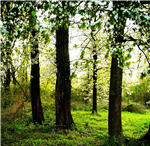A study recently published in Nature Climate Change finds that tropical vegetation contains 21 percent more carbon than previous studies had suggested. Using a combination of remote sensing and field data, scientists from Woods Hole Research Center (WHRC), Boston University, and the University of Maryland were able to produce the first "wall-to-wall" map (with a spatial resolution of 500 m x 500 m) of carbon storage of forests, shrublands, and savannas in the tropics of Africa, Asia, and South America.

The northern forests of western Canada are likely absorbing less carbon dioxide because of climate change, and the decline may be making a bad situation worse, researchers from Quebec and China have concluded.
Boise State University geophysics researchers have created a new way to study fractures by producing elastic waves, or vibrations, through using high-intensity light focused directly on the fracture itself. The new technique developed in the Physical Acoustics Lab at Boise State may help determine if there is a fluid, such as magma or water, or natural gas inside fractures in the Earth.
During the week of Feb. 6-12, 2012, representatives from the Environmental Protection Agency (EPA) and the Texas Department of State Health Services (TDSHS) will be in the area of South Alamo, Texas, to speak with residents about the contamination in the Donna Reservoir and Canal. This effort is being made to provide local residents with information about the health risks of consuming fish taken from the Donna Reservoir and Canal. The possession of contaminated fish taken from the reservoir is prohibited by the TDSHS.
Barry D. Bruce, professor of biochemistry, cellular and molecular biology, at the University of Tennessee, Knoxville, is turning the term "power plant" on its head. The biochemist and a team of researchers have developed a system that taps into photosynthetic processes to produce efficient and inexpensive energy.
A Stanford University research team has designed a high-efficiency charging system that uses magnetic fields to wirelessly transmit large electric currents between metal coils placed several feet apart. The long-term goal of the research is to develop an all-electric highway that wirelessly charges cars and trucks as they cruise down the road.
As the United States transitions away from a primarily petroleum-based transportation industry, a number of different alternative fuel sources—ethanol, biodiesel, electricity and hydrogen—have each shown their own promise. Hoping to expand the pool even further, researchers at the U.S. Department of Energy's Argonne National Laboratory have begun to investigate adding one more contender to the list of possible energy sources for light-duty cars and trucks: compressed natural gas (CNG).
If a tree falls in the forest and there are no enzymes to digest it, does it break down? It's a question that has important ramifications for the renewable energy industry. Engineers are studying methods to transform non-food plant material into transportation fuel. Think alfalfa stalks or wood-chips (which have energy contained in a molecule humans can't digest called cellulose), as opposed to the edible corn grains that are used in the production of ethanol for biofuels.
Due to its size, population and proximity to Puget Sound, Joint Base Lewis-McChord has received a proposed Municipal Stormwater discharge permit from the U.S. Environmental Protection Agency (EPA). The permit, when final, is expected to help guide how stormwater is managed across nearly 142 square miles of base property over the next decade and beyond.
A new service, developed by experts at The University of Manchester and The Mersey Forest, will provide vital information to help urban neighborhoods avoid the potentially dangerous effects of climate change.
Precipitous declines in formerly common mammals in Everglades National Park have been linked to the presence of invasive Burmese pythons, according to a study published today in the Proceedings of the National Academy of Sciences.
Consistent appraisals of homes and businesses outfitted with photovoltaic (PV) installations are a real challenge for the nation's real estate industry, but a new tool developed by Sandia National Laboratories and Solar Power Electric addresses the issue. Sandia scientists, in partnership with Jamie Johnson of Solar Power Electric, have developed PV ValueTM, an electronic form to standardize appraisals.
A study combines experimental observations of spider webs with complex computer simulations has shown that web durability depends not only on silk strength, but on how the overall web design compensates for damage and the response of individual strands to continuously varying stresses.
Cities across the globe are trying to develop plans to cut down their energy consumption and lower their carbon footprint by reducing the associated greenhouse gas emissions.
Some of the water used worldwide for irrigation comes from renewable sources such as local precipitation, rivers, lakes and renewable groundwater. But some comes from non-renewable groundwater sources.
Engineering researchers at the University of Arkansas are developing an emergency communications network that will maintain operation during natural disasters and provide critical warnings and geographic information to people affected by the disasters. The researchers are honing and testing the system now and expect to deploy a pilot network at the end of 2012.
A company looking to purchase an electric-powered delivery truck today will likely experience some sticker shock: Such a vehicle costs nearly $150,000, compared to about $50,000 for the same kind of truck with a standard internal-combustion engine.
Thirty-thousand-year-old bison bones discovered in permafrost at a Canadian goldmine are helping scientists unravel the mystery about how animals adapt to rapid environmental change.
The U.S. Environmental Protection Agency (EPA) recently announced that it will provide $9.8 million in grants to 38 states, territories and tribes to help protect the health of swimmers at America’s beaches. The agency also launched an improved website for beach advisories and closings, which will allow the public to access the most current water quality and pollution testing information for more than 6,000 U.S. beaches.

In an effort to discern fracking fact from fracking sensationalism, oil and natural gas leaders must band together for the future of energy and apply environmentally friendly chemicals to the hydraulic fracturing process.